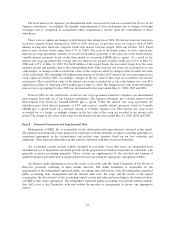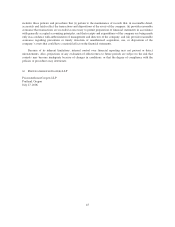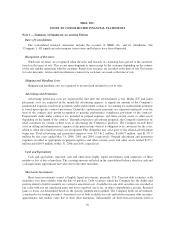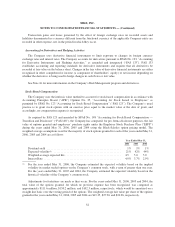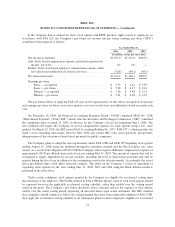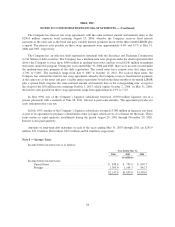Nike 2006 Annual Report Download - page 51
Download and view the complete annual report
Please find page 51 of the 2006 Nike annual report below. You can navigate through the pages in the report by either clicking on the pages listed below, or by using the keyword search tool below to find specific information within the annual report.NIKE, INC.
NOTES TO CONSOLIDATED FINANCIAL STATEMENTS
Note 1 — Summary of Significant Accounting Policies
Basis of Consolidation
The consolidated financial statements include the accounts of NIKE, Inc. and its subsidiaries (the
“Company”). All significant intercompany transactions and balances have been eliminated.
Recognition of Revenues
Wholesale revenues are recognized when the risks and rewards of ownership have passed to the customer,
based on the terms of sale. This occurs upon shipment or upon receipt by the customer depending on the country
of the sale and the agreement with the customer. Retail store revenues are recorded at the time of sale. Provisions
for sales discounts, returns and miscellaneous claims from customers are made at the time of sale.
Shipping and Handling Costs
Shipping and handling costs are expensed as incurred and included in cost of sales.
Advertising and Promotion
Advertising production costs are expensed the first time the advertisement is run. Media (TV and print)
placement costs are expensed in the month the advertising appears. A significant amount of the Company’s
promotional expenses result from payments under endorsement contracts. Accounting for endorsement payments
is based upon specific contract provisions. Generally, endorsement payments are expensed uniformly over the
term of the contract after giving recognition to periodic performance compliance provisions of the contracts.
Prepayments made under contracts are included in prepaid expenses and other current assets or other assets
depending on the length of the contract. Through cooperative advertising programs, the Company reimburses its
retail customers for certain of their costs of advertising the Company’s products. The Company records these
costs in selling and administrative expense at the point in time when it is obligated to its customers for the costs,
which is when the related revenues are recognized. This obligation may arise prior to the related advertisement
being run. Total advertising and promotion expenses were $1,740.2 million, $1,600.7 million, and $1,377.9
million for the years ended May 31, 2006, 2005 and 2004, respectively. Prepaid advertising and promotion
expenses recorded as appropriate in prepaid expenses and other current assets and other assets totaled $177.1
million and $169.9 million at May 31, 2006 and 2005, respectively.
Cash and Equivalents
Cash and equivalents represent cash and short-term, highly liquid investments with maturities of three
months or less at date of purchase. The carrying amounts reflected in the consolidated balance sheet for cash and
cash equivalents approximate fair value due to the short maturities.
Short-term Investments
Short-term investments consist of highly liquid investments, primarily U.S. Treasury debt securities, with
maturities over three months from the date of purchase. Debt securities which the Company has the ability and
positive intent to hold to maturity are carried at amortized cost. Available-for-sale debt securities are recorded at
fair value with any net unrealized gains and losses reported, net of tax, in other comprehensive income. Realized
gains or losses are determined based on the specific identification method. The Company holds no investments
considered to be trading securities. Amortized cost of both available-for-sale and held-to-maturity debt securities
approximates fair market value due to their short maturities. Substantially all short-term investments held at
50




